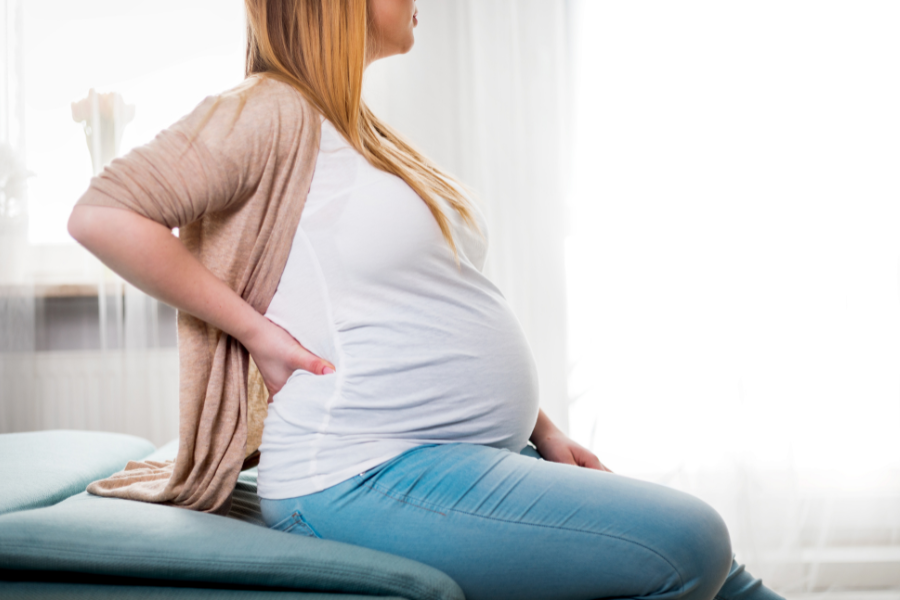- What Vein Conditions May Develop During Pregnancy?
- Symptoms of Vein Conditions During Pregnancy
- Vein Conditions During Pregnancy, Childbirth, and Postpartum
- Does Cancer Cause Varicose Veins?
- Can Vein Conditions Affect Your Baby?
- Understanding the Risk Factors
As you already know, pregnancy can bring significant changes to the body, but did you know that up to 40% of pregnant women experience varicose veins during pregnancy? When pregnant, women are also up to five times more likely to develop vein conditions as compared to those who are not pregnant.
At St. Johns Vein Center, we’re committed to providing comprehensive care for vein health, particularly during significant life stages such as pregnancy. Take a look at the risks, symptoms, and preventive measures so that you can reduce your risk of vein conditions during pregnancy.
What Vein Conditions May Develop During Pregnancy?
Pregnancy can cause physiological changes in women’s bodies that may result in various vein conditions. These conditions can cause discomfort and pose potential health risks by affecting the structure and function of veins.
Here are some vein conditions that pregnant women may experience:
- Varicose Veins: Varicose veins are swollen, twisted veins that often appear in the legs during pregnancy. The growing uterus puts pressure on the pelvic veins, slowing blood flow from the legs and causing veins to swell. Varicose veins can cause pain, discomfort, and aching sensations.
- Spider Veins: Spider veins are small, dilated blood vessels that may develop on the legs, face, or other areas during pregnancy. Hormonal changes and increased blood volume can contribute to the development of spider veins. They are typically harmless but may cause cosmetic concerns for some women.
- Deep Vein Thrombosis (DVT): While less common, pregnant women are at increased risk of developing DVT, especially in the later stages of pregnancy or during the postpartum period. DVT occurs when a blood clot forms in a deep vein, usually in the legs. It can cause swelling, pain, and potentially serious complications if the clot dislodges and travels to the lungs.
- Chronic Venous Insufficiency (CVI): CVI may worsen during pregnancy due to hormonal changes and increased pressure on the veins. CVI occurs when the valves in the veins become damaged or weakened, leading to poor blood flow back to the heart. Symptoms may include swelling, pain, and skin changes, such as discoloration or ulcers.
- Superficial Venous Thrombosis (SVT): SVT is an inflammation of a superficial vein close to the skin’s surface that frequently results in the formation of blood clots. Pregnant women may experience SVT due to hormonal changes and increased blood volume. It can cause pain, redness, and swelling in the affected area.
Vein conditions during pregnancy can vary in severity, and it’s important to seek medical attention if you experience any symptoms or concerns related to vein health.
Symptoms of Vein Conditions During Pregnancy
Recognizing the symptoms of vein conditions helps with early detection and intervention.
These symptoms may appear as:
- Pain, swelling, and tenderness in one leg, often concentrated in the calf region
- A sensation of heaviness or warmth in the affected leg
- Skin discoloration or redness, particularly below the knee
- Enlarged or prominent veins
- Swelling or bluish discoloration of the toes
Approximately 50% of individuals with acute vein conditions may not exhibit any symptoms, underscoring the significance of regular screenings and heightened awareness, especially during pregnancy.
Vein Conditions During Pregnancy, Childbirth, and Postpartum
Vein conditions during pregnancy, childbirth, and the postpartum period present unique challenges and considerations for expectant mothers. While pregnancy is a beautiful and transformative experience, it can also bring about changes in the body that affect vascular health.
During Pregnancy
During pregnancy, the body undergoes significant physiological changes to support the growing fetus. These changes can impact the vascular system, leading to various vein conditions. Some common vein conditions experienced during pregnancy include:
- Varicose Veins
- Spider Veins
- Deep Vein Thrombosis (DVT)
During Childbirth
Childbirth can worsen existing vein conditions or lead to new issues due to the increased pressure on veins during labor.
- Increased Blood Flow: During labor and delivery, there is a significant increase in blood flow throughout the body, including the pelvic area. This can exacerbate the symptoms of varicose veins and contribute to discomfort or swelling.
- Hemorrhoids: Hemorrhoids, swollen veins in the rectal area, are a common issue during childbirth due to increased pressure on the pelvic veins. Symptoms may include pain, itching, and bleeding during bowel movements.
Postpartum Period
The postpartum period, or the weeks and months following childbirth, is a critical time for vein health as the body undergoes further adjustments. It’s essential to monitor vein conditions during this time and seek appropriate care if needed.
- Residual Symptoms: Many women experience lingering symptoms of vein conditions postpartum, such as persistent varicose veins or swelling in the legs. These symptoms may gradually improve over time but should be monitored closely.
- Venous Thromboembolism (VTE) Risk: The postpartum period is associated with an increased risk of VTE, including DVT and pulmonary embolism. It’s essential to be aware of the signs and symptoms of VTE and seek prompt medical attention if any concerns arise.
Can Vein Conditions Affect Your Baby?
Vein conditions that occur during pregnancy mainly affect the mother’s health, but they may indirectly impact the baby’s well-being. Although the direct risk to the baby is relatively low compared to the potential dangers of untreated vein conditions in the mother, it is important to be aware of possible implications for both maternal and fetal health.
Here is a breakdown of how vein conditions during pregnancy can indirectly affect the baby:
Maternal Health Impact
- Complications of Untreated Vein Conditions: If vein conditions such as varicose veins or deep vein thrombosis (DVT) are left untreated, they can lead to complications such as chronic pain, skin ulcers, or venous thromboembolism (VTE). These complications can impact the mother’s ability to care for herself and her baby during pregnancy and postpartum.
- Mobility and Activity Limitations: Severe vein conditions may limit the mother’s mobility and ability to engage in physical activity, which can impact overall pregnancy health and fetal development. Reduced activity levels may also contribute to increased discomfort or complications during labor and delivery.
Medication Considerations
- Treatment with Anticoagulants: In some cases, pregnant women with vein conditions may require treatment with anticoagulant medications to prevent blood clots or manage symptoms. While these medications are generally considered safe during pregnancy, they may require careful monitoring and adjustment to ensure maternal and fetal safety.
- Impact on Breastfeeding: Women receiving anticoagulant therapy during pregnancy may need to discontinue or adjust their medication regimen during breastfeeding to minimize potential risks to the baby. Healthcare providers can provide guidance on safe medication use during pregnancy and lactation.
Potential Stress and Anxiety
- Emotional Impact: Dealing with vein conditions during pregnancy, especially if they cause discomfort or complications, can contribute to maternal stress, anxiety, or depression. While these emotional factors may not directly affect the baby’s physical health, they can influence maternal well-being and potentially impact the overall pregnancy experience.
Understanding the Risk Factors
Several factors increase the risk of vein conditions during pregnancy, including:
- Previous history of vein conditions or blood clots
- Family history of vein conditions
- Advanced maternal age (over 35)
- Obesity or high body mass index (BMI)
- Multiple pregnancies (e.g., twins or triplets)
- Prolonged periods of immobility
- Smoking
- Certain medical conditions, such as preeclampsia or inflammatory bowel disease
- Prevention and Management Strategies
To mitigate the risk of vein conditions during pregnancy, proactive measures are essential:
- Engage in regular, pregnancy-safe exercises to promote circulation
- Wear compression stockings to alleviate pressure on veins and reduce swelling
- Avoid prolonged periods of sitting or standing still
- Maintain hydration and adhere to a healthy lifestyle
- Follow prescribed anticoagulant medication regimens under medical supervision
- Attend regular monitoring appointments with healthcare providers
- Taking a comprehensive approach to prevention and management is vital for effectively addressing vein conditions during pregnancy.
Vein conditions that occur during pregnancy require careful attention. However, the risks associated with these conditions can be minimized by taking proactive measures and seeking proper medical care.
Next Steps for Pregnant Mothers with Vein Conditions
If you are worried about your vascular health during pregnancy, we recommend scheduling an appointment with one of our vascular specialists at St. Johns Vein Center. We are committed to supporting you throughout your journey towards a healthy pregnancy and beyond.
Frequently Asked Questions About Pregnancy and Vein Conditions
What are the earliest signs of vein conditions during pregnancy that I should watch out for?
Early detection of vein conditions is typically facilitated during routine visits with an OB/GYN or vascular specialist. Mothers should remain vigilant for symptoms that may indicate the presence of vein conditions, especially during pregnancy. These symptoms can often mimic typical discomforts associated with pregnancy but may signify underlying vascular issues. Some signs to watch out for include swelling, pain or tenderness, heavy aches, warmth and redness, and skin discoloration.
How does pregnancy increase the risk of developing vein conditions, and are some women at higher risk than others?
Pregnancy introduces physiological changes that heighten the risk of vein conditions. The body’s clotting mechanisms become more active during pregnancy to prevent excessive bleeding during childbirth.
Furthermore, as the uterus expands, it applies pressure to the pelvic veins, impeding blood flow from the legs. Certain factors, such as advanced maternal age, high BMI, and a history of clotting disorders, increase the likelihood of vein issues during pregnancy.
Is taking medications for vein conditions safe during pregnancy, and how do they affect the baby?
Certain medications used to manage vein conditions are generally safe during pregnancy. Your healthcare provider will assess the benefits and risks to ensure your safety and your baby’s.
Can lifestyle changes make a difference in preventing vein conditions during pregnancy, and what specific actions are most effective?
Certain lifestyle modifications are important for minimizing the risk of vein conditions during pregnancy. Regular physical activity, including pregnancy-safe exercises, promotes better circulation and reduces the likelihood of blood clots. Wearing compression stockings, staying hydrated, and avoiding prolonged periods of inactivity also help maintain vein health. For those who are at a higher risk of vein conditions, healthcare providers may suggest personalized strategies to mitigate risks effectively. By adopting these lifestyle changes, one can significantly contribute to safeguarding overall health during pregnancy.
What should I do if I suspect I have a vein condition during pregnancy? Who should I contact first?
If you think you may have a vein condition, it is important to seek medical attention promptly. You can contact your healthcare provider or visit the nearest emergency room. Early diagnosis and treatment are essential for preventing complications. If you experience worrying symptoms, do not wait to seek medical help.








